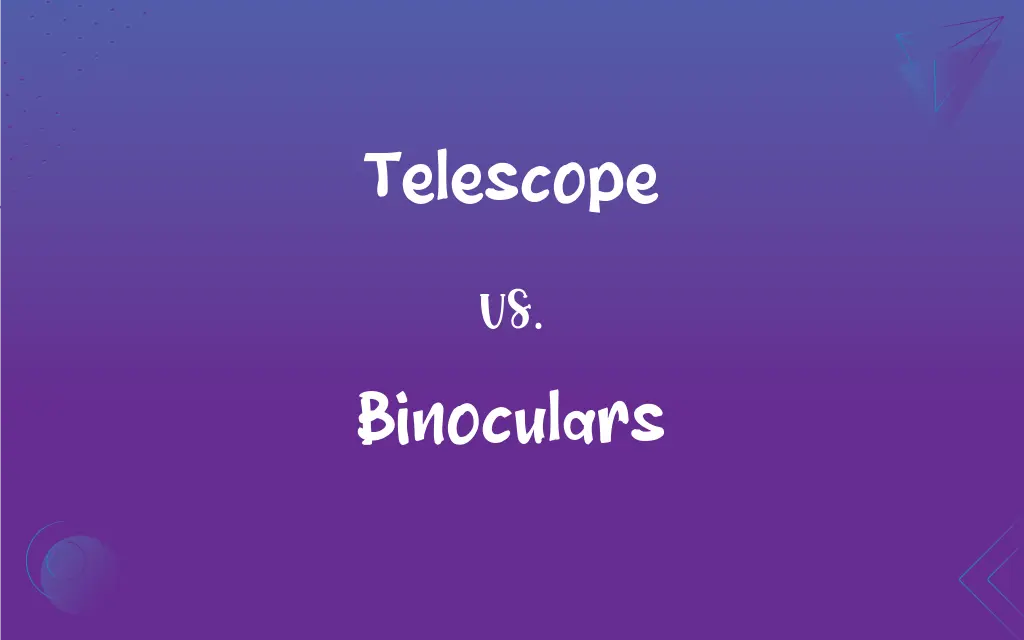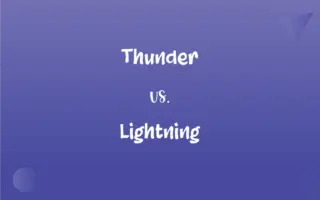Telescope vs. Binoculars: What's the Difference?
Edited by Janet White || By Harlon Moss || Updated on October 21, 2023
A telescope is an optical instrument designed to magnify distant objects, often with one eyepiece, while binoculars are paired optical devices for both eyes to view nearby objects with increased clarity.

Key Differences
A telescope and binoculars are both optical instruments designed to bring distant objects closer to the viewer's perspective, though their constructions and purposes can differ.
While a telescope typically uses one eyepiece and is frequently used to observe celestial bodies, binoculars consist of two aligned telescopes designed for terrestrial observation.
Amateur astronomers might set up a telescope to gaze upon stars, planets, and nebulae, whereas binoculars are common among bird watchers, tourists, and sports enthusiasts.
The primary function of a telescope is magnification, while binoculars prioritize both magnification and creating a three-dimensional view for the observer.
When considering field of view, a telescope offers a narrower field due to its design, while binoculars provide a broader field, making them suitable for observing moving or expansive scenes.
ADVERTISEMENT
Comparison Chart
Eyepieces
Usually one
Two
Primary Use
Celestial observation
Terrestrial observation
Field of View
Narrow
Broad
Magnification Focus
High magnification of very distant objects
Moderate magnification of relatively closer objects
Design
Singular, often larger and mounted
Paired, compact, and handheld
ADVERTISEMENT
Telescope and Binoculars Definitions
Telescope
Telescopes can be refracting or reflecting.
Newton invented a type of reflecting telescope.
Binoculars
Binoculars consist of two aligned telescopes.
I used binoculars to watch the eagles nest from afar.
Telescope
A telescope is an optical device for observing distant objects.
Galileo made pioneering observations using a telescope.
Binoculars
Binoculars provide a three-dimensional view.
With binoculars, the deer appeared close and vividly three-dimensional.
Telescope
Telescopes are primary tools for astronomers.
The Hubble Space Telescope has provided stunning images of the universe.
Binoculars
Binoculars are popular for bird-watching.
He pulled out his binoculars to spot the rare bird in the tree.
Telescope
Some telescopes are designed for radio frequencies.
The Arecibo Observatory was a famous radio telescope.
Binoculars
Most binoculars are designed to be handheld.
She kept her binoculars on a strap around her neck.
Telescope
Telescopes can be ground-based or space-based.
The James Webb Space Telescope will be launched into space for infrared observations.
Binoculars
Binoculars vary in magnification and lens size.
For the concert, compact binoculars with a smaller lens size would suffice.
Telescope
An arrangement of lenses or mirrors or both that gathers light, permitting direct observation or photographic recording of distant objects.
Binoculars
Relating to, used by, or involving both eyes at the same time:binocular vision.
Binoculars
Having two eyes arranged to produce stereoscopic vision.
Binoculars
OftenbinocularsAn optical device, such as a pair of field glasses or opera glasses, designed for simultaneous use by both eyes and consisting of two small telescopes joined together.
Binoculars
A hand-held device consisting of a series of lenses and prisms, used to magnify objects so that they can be better seen from a distance, and looked at through both eyes.
Binoculars
An optical instrument designed for simultaneous use by both eyes
FAQs
Are binoculars suitable for kids?
Yes, there are binoculars specifically designed for kids that are lightweight and durable.
Can you use binoculars for astronomy?
Yes, binoculars can be used for casual astronomy, especially for viewing the moon or larger constellations.
How does a refracting telescope differ from a reflecting telescope?
A refracting telescope uses lenses, while a reflecting telescope uses mirrors to gather and focus light.
Can you take pictures through a telescope?
Yes, with the right equipment like an adapter, you can attach a camera to a telescope for astrophotography.
Why do binoculars sometimes have numbers like "8x42" on them?
These numbers indicate magnification (8x) and lens diameter in millimeters (42mm).
Are all telescopes suitable for viewing planets?
Not all. The type, aperture, and magnification of the telescope can determine its suitability for planetary viewing.
What's the advantage of using binoculars over a single-lens telescope for terrestrial viewing?
Binoculars offer a three-dimensional, wider field of view and are generally more portable than telescopes.
How has technology improved the telescope over time?
Advancements in optics, computerized tracking, and adaptive optics have greatly enhanced telescope capabilities.
Which is better for stargazing, a telescope or binoculars?
A telescope is typically better for detailed stargazing, especially for distant celestial objects.
How do you maintain and clean a telescope?
Dust it lightly, avoid touching the optics, and for deeper cleaning, use specialized cleaning solutions and techniques.
Can you use binoculars for marine observation?
Yes, there are marine binoculars that are waterproof and designed for nautical use.
Why is space the best location for some telescopes?
Space-based telescopes avoid atmospheric interference, allowing clearer and more detailed observations.
Can both telescopes and binoculars be digital?
Yes, there are digital versions of both that can capture and store images electronically.
What's a space telescope?
A space telescope is positioned outside Earth's atmosphere, like the Hubble Space Telescope, to avoid atmospheric distortion.
How do I choose the right magnification for binoculars?
Consider your purpose. Higher magnification offers closer views but may be shakier, while lower magnification provides a broader field of view.
Can binoculars be used with a tripod?
Yes, many binoculars can be mounted on a tripod using an adapter for steadier viewing.
Why might someone choose binoculars over a telescope for casual sky watching?
Binoculars are more portable, offer a wider field of view, and are easier to use for beginners.
How has the telescope impacted science?
The telescope revolutionized astronomy by allowing detailed observations of celestial bodies, leading to numerous discoveries.
Are there binoculars designed for nighttime?
Yes, night vision binoculars amplify available light to allow viewing in low-light conditions.
What's the difference between optical and radio telescopes?
Optical telescopes observe visible light, while radio telescopes detect radio waves emitted by celestial sources.
About Author
Written by
Harlon MossHarlon is a seasoned quality moderator and accomplished content writer for Difference Wiki. An alumnus of the prestigious University of California, he earned his degree in Computer Science. Leveraging his academic background, Harlon brings a meticulous and informed perspective to his work, ensuring content accuracy and excellence.
Edited by
Janet WhiteJanet White has been an esteemed writer and blogger for Difference Wiki. Holding a Master's degree in Science and Medical Journalism from the prestigious Boston University, she has consistently demonstrated her expertise and passion for her field. When she's not immersed in her work, Janet relishes her time exercising, delving into a good book, and cherishing moments with friends and family.
































































